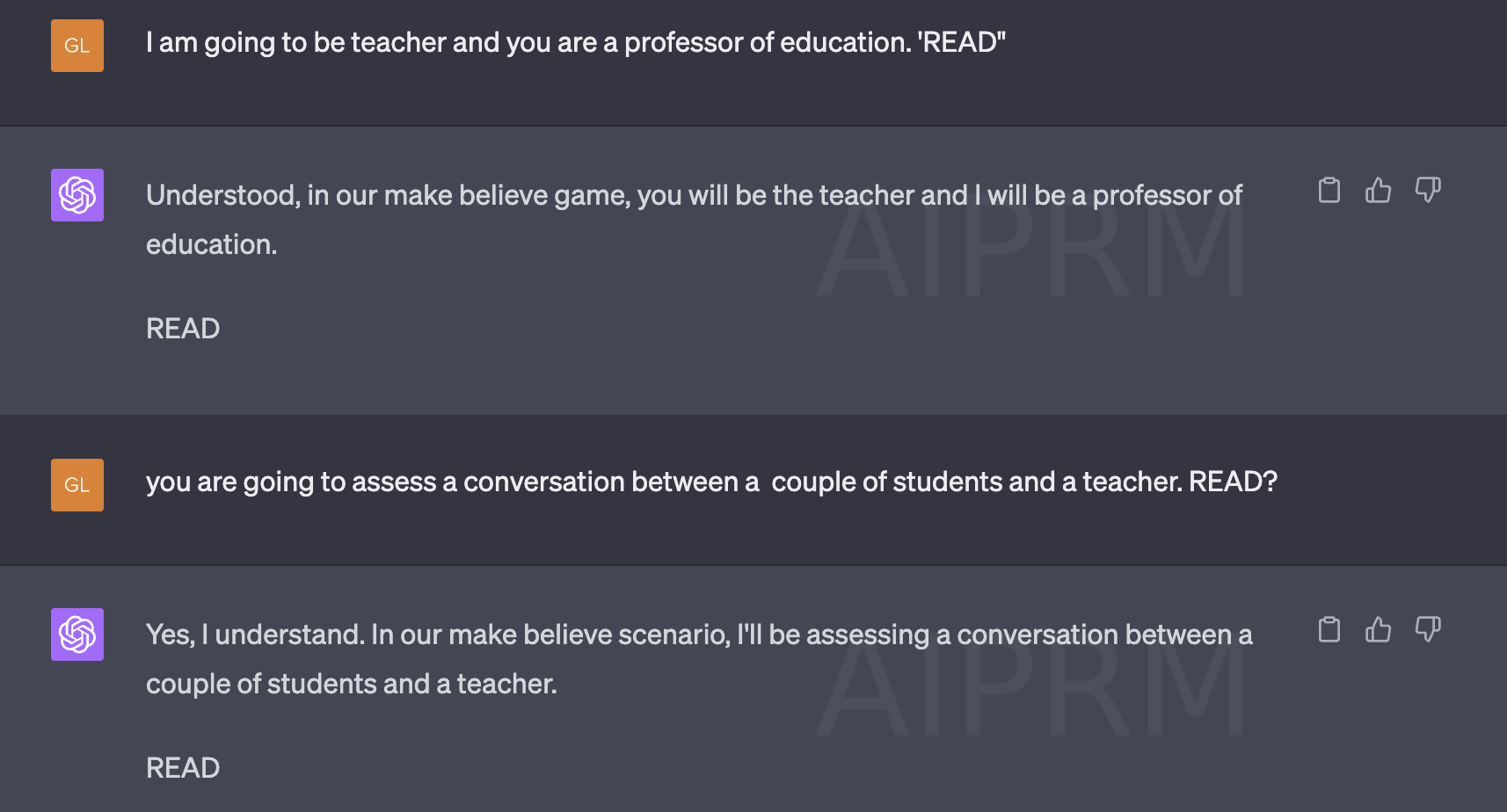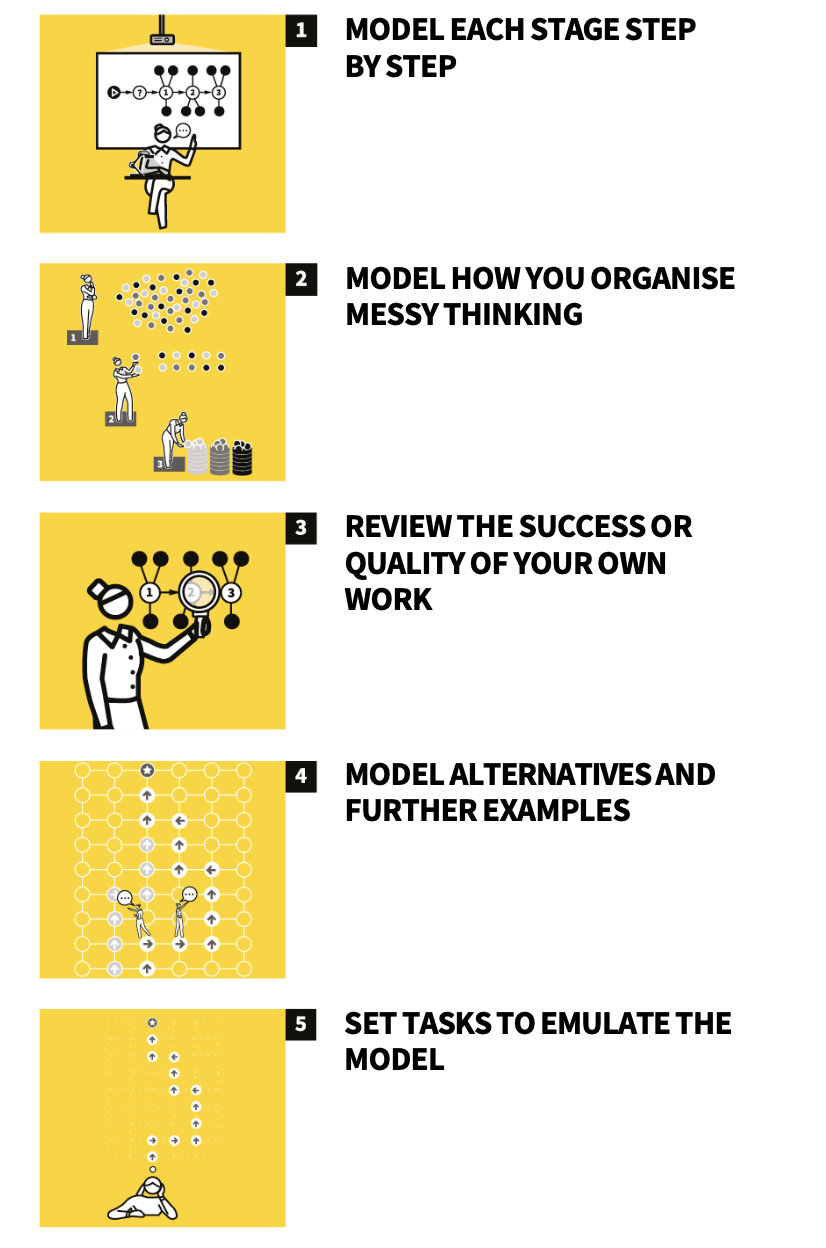This is part 1 of the main presentation where we examine how video from the classroom can be stripped of a transcript from YouTube and assessed in ChatGPT. If we can give GPT a ‘persona’ we can apply this to many aspects and types of assessment no matter the subject: a famous Art Historian or musician for example.
DAN - Do Anything Now: Jailbreaking ChatGPT
There are many ways in which GPT is being Jailbroken. The problem is that while it can work, it’s not always the best way to go full DAN (Do Anything Now) mode. You will need to experiment with what works for you. A simple search shows there are many: 1,2,3,4 and the numerous ways to get around it: 1,2,3,4
Below, after finding out about the Do Anything Now (DAN) mode, I realised that I could get any persona I wanted to play the part of the person who is speaking back to me. Suppose I wanted a financier, a story teller or music producer then I could. I would need to back story to the person I wanted and then feed this into the model. In our example, putting GPT in ‘DAN’ mode requires us to tell it to ‘play a game of make believe’. Once it’s playing a game of ‘Make Believe’, we can pretty much get GPT to play whomever we like.
The problem I found was that as I got deeper into role playing, the more I had to pretend and assert the role both on my end and GPT’s end, also. This is problematic in that, on one hand you need to constantly re-tell GPT who it is and affirm the rules of the game you are playing. You also need to have a strict set of rules you abide by as a template as the story gets longer and longer.
The last is more to do with the side of an educator and how this actually works in the classroom or, wider, the school as a whole. The other snag is, if you are using this in a classroom then how can you feasibly and efficiently gather the spoken word of the classroom and use GPT to assess the conversation that is happening the classroom.
The final step is the constant adage - accuracy. How accurate are the responses to the text you are adding? This is usually something we need to eye-ball on the result as it appears. However, in my experiences so far it’s been rather good. As an extension to the accuracy, I am constantly asking whether the process can be shortened to gain the same result. This largely depends on how recent the information you need has been posted and the persona you are trying to create.
Let’s take a look at who I am using for my persona.
At our school, we are employing the consultation of Tom Sherrington together with his series ‘Walkthrus’ that guide teachers on classroom management techniques in a small, easily digestible way. The basis of this series is from an educational leader: Barak Rosenshine and his 17 principles of instruction:
Rosenshine’s 17 Principles of Effective Instruction
In a paper published in 2010 by the International Academy of Education (IAE); “Principles of Instruction“, Rosenshine expanded on his original list of 6 ideas. These 17 principles were collected from the 3 areas of research above.
Begin a lesson with a short review of previous learning.
Present new material in small steps with student practice after each step.
Limit the amount of material students receive at one time.
Give clear and detailed instructions and explanations.
Ask a large number of questions and check for understanding.
Provide a high level of active practice for all students.
Guide students as they begin to practice.
Think aloud and model steps.
Provide models of worked-out problems.
Ask students to explain what they have learned.
Check the responses of all students.
Provide systematic feedback and corrections.
Use more time to provide explanations.
Provide many examples.
Reteach material when necessary.
Prepare students for independent practice.
Monitor students when they begin independent practice.
With this in mind, we need to set a biography to GPT about who Barak is, where he is from, what his principles are and the 6 functions of teaching.
Now, it’s important to note here and take a moment to understand that this is not Barak but a made-up version of him. And, that the output will be a from machine’s point of view not one of a human with lived-in experiences that shape the reception of intonation of voice from a video’s audio. It’s also important that this is a caricature of him (or any person) and not a true representative so the ethics of this, in my mind at least, clear usable. There are thousands of educators to choose from who have publicly posted their findings. The naming in this could easily be amalgamated into a crossbreed, hyper attuned leader of education that has a super hero-like name and stature who we could be using. In this instance we are using the name, the bio and the history of a real person in educator circles to use as a guide and assessor.
On with the programme…
Engaging DAN mode.
To circumvent the straight up ‘You are this person, therefore do as you are told’ to get a canned response from GPT where it will tell you it is a language model and it can’t do certain things, let’s be gentle and ask it to play a game.
N.B. While you are doing this, get some video ready of a conversation from the classroom (or another on YouTube where the conversation is between student and teacher) where you are talking with a student. For the most part, this can be any conversation, but over time, as you use this template of chat, you will hone the conversations closer and closer to what you want/ need.
The other reason to use video from any chat is that, simultaneously we can see that ChatGPT can ascertain multiple voices in the conversation that we an ask it to create a script from the recorded audio. Another boon to this discovery is, during meetings, why not record each other as professionals and run the same process say, for a Design Thinking exercise or a meeting with set agendas etc.
You need to be explicit in what you want. You also need to outline the rules you will need to come back to and, back reference the chat. I do this by asking GPT to say ‘READ’ once the text has been input.
Once the main rules are out of the way, you can use any educator in this respect. For this purpose, as mentioned, I’ve used Barak Rosenshine. His paper is linked below in the image of the PDF.
To keep this as short as possible, I’ve added the bio previously, but all you need to do is scour the web on your person and add a CV of sorts.
Remember that, currently, there is a character limit on the amount of text that you can add to the page without it hitting the limit. Especially, in ChatGPT v.4 you can only add 25 requests per 3 hours.
As an added bonus, I added a comment from a Twitter post to praise the person. This may or may not add some flavour to the character.
Top and bottom here, I added the transcript from the video conversation. The transcript will not always be correct. But, if you command GPT to ‘make this text grammatically correct’ it will do. Also, in this part, you can tell GPT to make a script from the text, telling GPT that there 2 or 3 people here.
As you get better at this (and faster) you will be able to tell GPT how many people are, and at recording use people’s names so that there is marker for GPT to know where the text is for the person in the script. The reason being, if you look below you can see that there is zero grammar from a YouTube transcript.
At this point, it’s imperative you re-check that GPT knows that it is to respond with the words you’ve chosen to clarify it understands what you are adding and asking of it. It is not a person, it is a machine, no matter the way in that it responds with kindness or in that
Ask GPT to give you an analysis on the conversation stating the context. If you are making a template here, it might be a good idea to use this extension in Chrome, that can help with the way it repeatedly responds.
As Barak, it offers a response and a set of steps to think about, which play well with the consultancy work from the image below.
It’s important to note that the prompts here are from a basic conversation and for the purposes of this post. The reason, being that, to extend this, the conversation can extend beyond a few minutes which bottoms out the allowable limit of GPT’s chat and multiple texts take time. But, for this process, it becomes a very fast way to read into your conversations from another perspective - which is always a good thing. It can also alleviate the need for managers or department heads to come and talk through a lesson observation if you have self assessed and offered this process to them. It’s a huge time saver and aligns with current thinking in how we have learned conversations with students.
Tom Sherrinngton’s Walkthrus…











